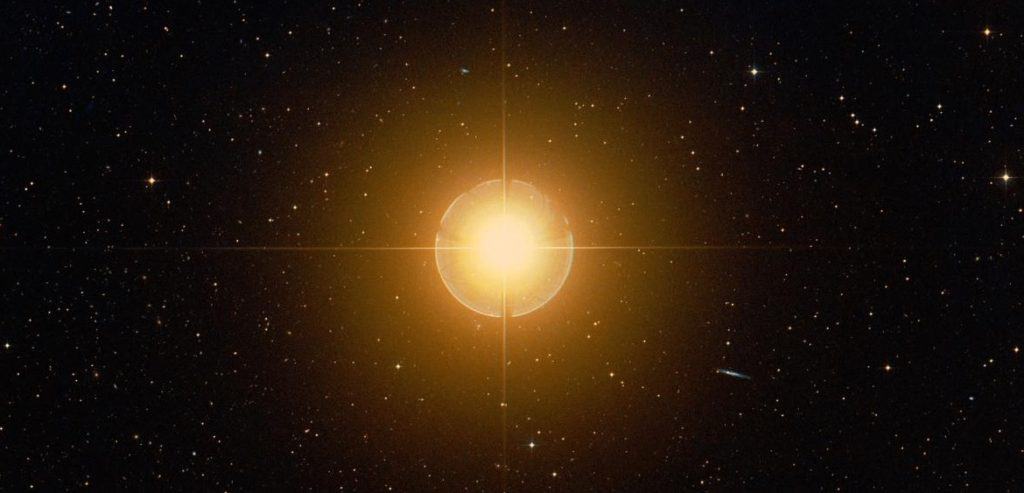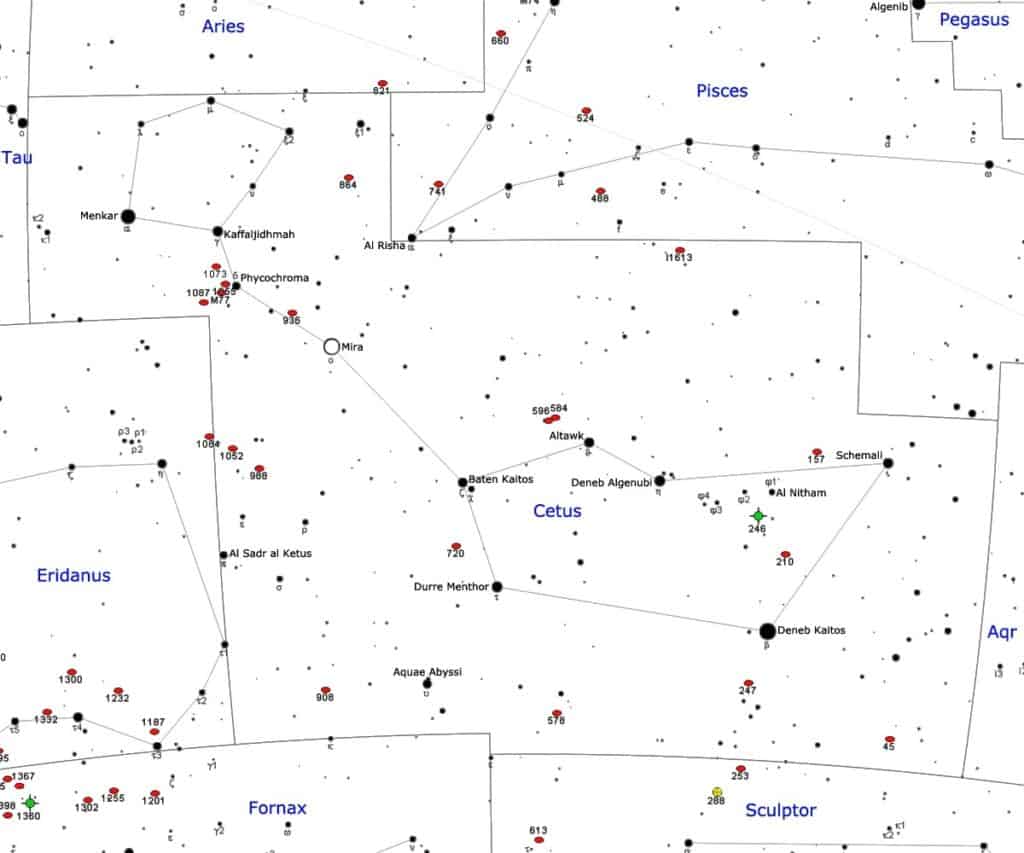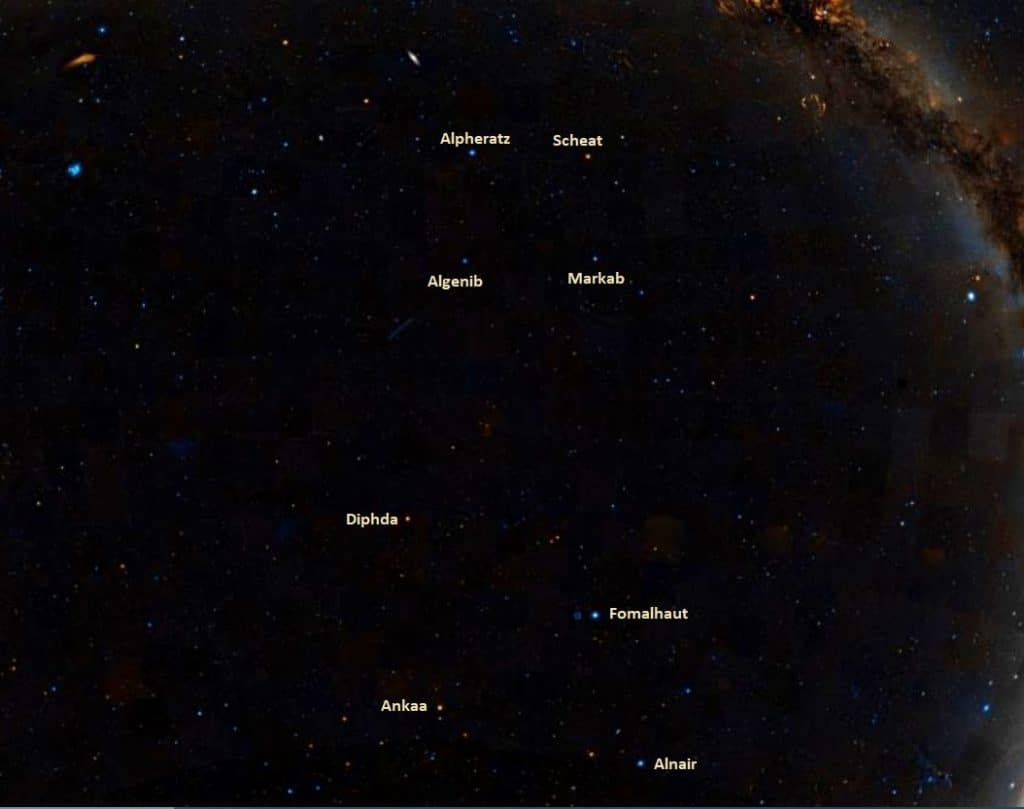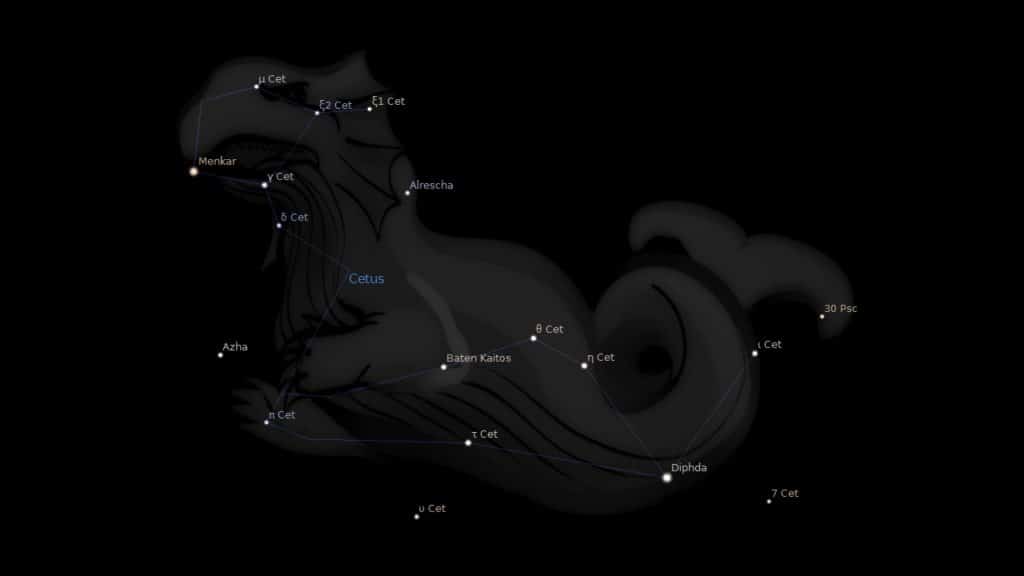Diphda, designated as Beta Ceti, is the brightest star in the constellation of Cetus, the celestial sea monster, slain by the Greek hero Perseus.
Key Facts & Summary
- Diphda is located at around 96.3 light-years away from our Solar System.
- It has an apparent magnitude of 2.02, and an absolute magnitude of -0.13.
- Diphda is an orange giant star of spectral type K0 III.
- This star is emitting 2,000 times the X-ray luminosity of the Sun.
- Diphda has around 2.8 solar masses and 16.78 solar radii. It is more than 30 times bigger than our Sun.
- The surface gravity on this star has been recorded at 2.7 cgs.
- Diphda is 139.1 times brighter than our Sun.
- This star is cooler than our Sun, having average surface temperatures of around 4,797 K.
- Diphda has a rotational velocity of 18 km / 11.1 mi per second, and a radial velocity of +12.9 km / +8 mi per second.
- This star is younger than our Sun, being only 1 billion years old.
- Diphda started its life as an A-type star, however, it has exhausted its hydrogen supplies in its core, and it has started to expand as it has evolved away from the main-sequence.
- Diphda outshines the red giant Menkar / Alpha Ceti, which is designated as the alpha star of the constellation of Cetus. In many cases, the alpha stars aren’t the brightest stars in their constellation.
- The constellation of Cetus is among the first 48 Greek constellations, first listed by astronomer Ptolemy, in his 2nd century Almagest.
- Cetus is now among the 88 modern constellations where it holds the title of the 4th largest constellation in the sky, stretching for around 1.231 square degrees.
- There are many interesting stars and deep-sky objects located in the constellation of Cetus. The best time to observe them, and the brightest star Diphda, is during the month of November when the constellation is the most prominent in the sky.
β Ceti
Beti Ceti is known by its traditional name Diphda, or Deneb Kaitos, which is of Arabic origin, and it translates to“the second frog”, the first frog being the 18th brightest star in the sky, Fomalhaut.

The second name, Deneb Kaitos, translates to the “southern tail of Cetus”, denoting the star’s position in its constellation. In late 2016, the IAU approved the name Diphda for the Beta Ceti star.
Formation
Diphda formed around 1 billion years ago from an interstellar medium of gas and dust. Gravity pulled the swirling gas and dust together and resulted in the brightest star in Cetus, Diphda / Beta Ceti.
Distance, Size, and Mass
Diphda is located at around 96.3 light-years away from our Solar System. It is bright enough to be visible to the naked eye.
Diphda has around 2.8 solar masses, or 280% of our Sun’s mass, and 16.78 solar radii, or 1,678% of our Sun’s radius. This star is thus more than 5 times bigger than our Sun.
Other Characteristics
Diphda / Beta Ceti is an orange giant star of spectral type K0 III. It has exhausted its hydrogen supplies within its core, and it has started to expand.
Diphda was most likely an A-type star of the main-sequence before it started to evolve away. When Diphda passed through its red giant phase, it underwent a helium flash event.

This star displays flaring activity that results in random outbursts that increase its luminosity over intervals lasting for several days. This star was recorded to emit around 2,000 times the X-ray luminosity of the Sun.
Diphda has an apparent magnitude of 2.02, and an absolute magnitude of -0.13, outshine the alpha star of its constellation, the red giant Menkar.
This star is 139.1 times hotter than our Sun, and its surface gravity has been recorded at 2.7 cgs. Diphda is cooler than our Sun, with temperatures reaching 4,797 K ( 1,000 K cooler than our Sun).
Diphda has a rotational velocity of 18 km / 11.1 mi per second, and a radial velocity of +12.9 km / +8 mi per second.
Location
Diphda / Beta Ceti is located in the constellation of Cetus, the celestial sea monster that was slain by the Greek hero Perseus. Diphda is the brightest star in the constellation, outshining the alpha star Menkar.

Diphda is located in an area of the sky devoid of bright stars. The star is located northeast of the 18th brightest star in the sky, Fomalhaut / Alpha Piscis Austrini.

Diphda has several galaxies in its vicinity, such as the bright spiral galaxy NGC 247, or the barred spiral galaxy NGC 175 / PGC 2526, which is the closest galaxy to Diphda.

The constellation of Cetus is among the first 48 Greek constellations, first listed by astronomer Ptolemy, in his 2nd century Almagest. Cetus is now among the 88 modern constellations where it holds the title of the 4th largest constellation in the sky, stretching for around 1.231 square degrees.
There are many interesting stars and deep-sky objects located in the constellation of Cetus. Among them, there is Mira / Omicron Ceti, which is a well-known variable star, Tau Ceti, the nearest Sun-like star to Earth, and hosts five candidate exoplanets, or UV Ceti, a prototype for a class of flare stars, among others.

Some important deep-sky objects in Cetus are the barred spiral galaxy Messier 77 / Cetus A, the spiral galaxy near Diphda, NGC 247, the spiral galaxies NGC 1042, and NGC 1035, the edge-on spiral galaxy NGC 1055, the irregular dwarf galaxy IC 1613, or the bright planetary nebula NGC 246, which is also known as the Cetus Ring, Skull Nebula, or Pac-Man Nebula.
The 10 brightest stars in the constellation of Cetus are Diphda – magnitude 2.02, Menkar – magnitude 2.53, Kafflajidhma – magnitude 3.47, Tau Ceti – magnitude 3.50, Iota Ceti – magnitude 3.562, Theta Ceti – magnitude 3.60, Baten Kaitos – magnitude 3.742, Upsilon Ceti – magnitude 3.95, and Delta Ceti – magnitude 4.06.
The pulsating variable star Mira / Omicron Ceti can become the brightest star in the constellation at times, while it can also be invisible to the naked eye since its brightness varies from magnitude 2.0 to 10.1.

The best time of the year to observe Diphda, the other stars, and deep-sky objects in the constellation of Cetus, is during the month of November when it is the most prominent in the sky.
The Future
When Diphda passed through its red giant phase, it underwent a helium flash event, and it has begun generating energy through the thermonuclear fusion of helium at its core. Diphda / Beta Ceti will remain in this mode for over 100 million years.
Did you know?
- The Chinese know Diphda as Tusikong – Master of Constructions. The Master of Constructions is a Chinese asterism and it is part of the Legs mansion, which marks the legs of the White Tiger. Diphda is the only star in this asterism.
- Diphda is among the 58 stars selected for celestial navigation. Diphda and Menkar are among the only stars from the Cetus constellation who are part of this selective group. Only the brightest and the most easily recognizable stars are selected for celestial navigation.
- The USS Diphda (AKA-59) was a U.S. Navy ship that was named after this star.
Sources:
Image Sources:
- https://www.star-facts.com/wp-content/uploads/2020/04/Diphda.jpg?189db0&189db0
- https://upload.wikimedia.org/wikipedia/commons/d/d4/Bceti_xray.jpg
- https://www.star-facts.com/wp-content/uploads/2020/04/Cetus-constellation.jpg?189db0&189db0
- https://www.star-facts.com/wp-content/uploads/2020/04/Diphda-and-NGC-247.jpg?189db0&189db0
- https://www.star-facts.com/wp-content/uploads/2020/04/Diphda-location.jpg?189db0&189db0
- https://astrologyking.com/wp-content/uploads/cetus-constellation.jpg
- https://www.go-astronomy.com/images/constellations/Cetus.jpg
